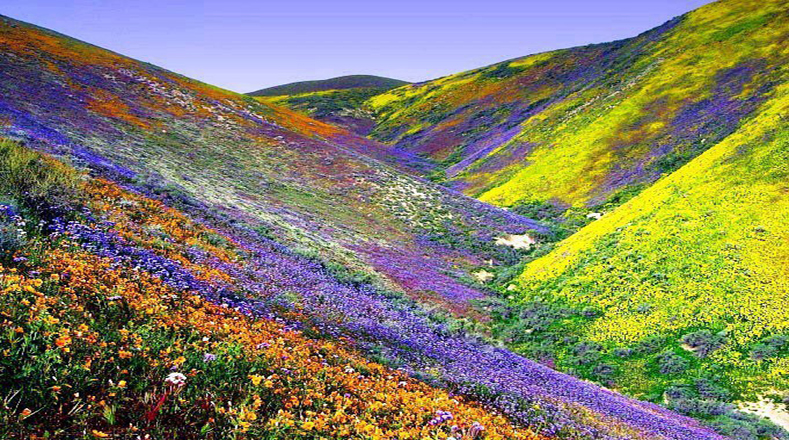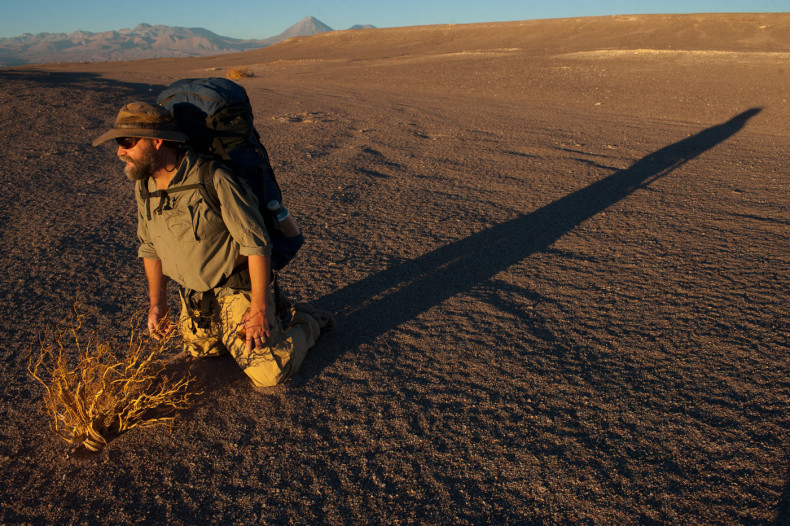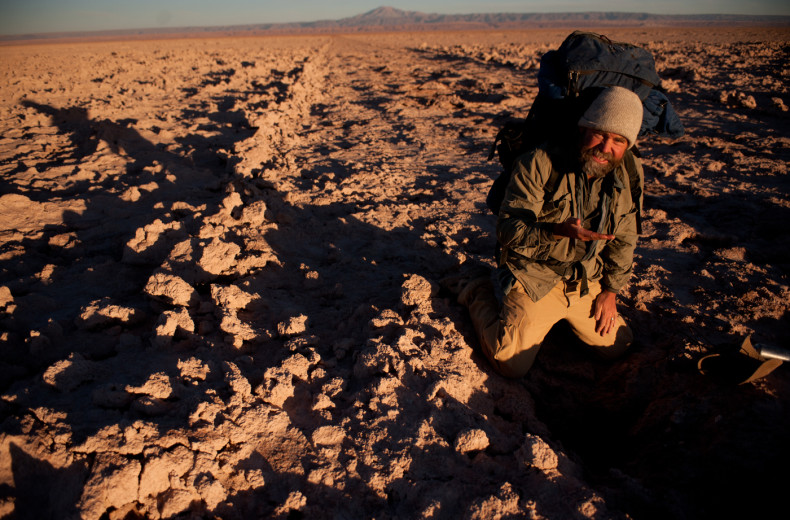This essay originally ran November 11, 2015, and is reappearing here as part of Atacama Week.
Rain has been falling on the driest non-polar desert in the world, famous for parts of it not seeing a drop of rain for centuries. The Atacama Desert in South America is caught in the rain shadow of the Andes on one side, and cold dry air washing in from an Antarctica ocean current on the other. This year, el Niño is on. Warmer waters are pushing against the West Coast of South America allowing rain to come to a rainless place. Last March, seven years of rain in a place that averages less than 4 millimeters a year fell overnight. The result has been an explosion of wildflowers, their seeds waiting in the hard dry soils for this very moment.
In August even more rain fell and a second even wilder bloom followed. A barren country where you can walk for days without seeing an ant, a fly, or a blade of grass erupted in a gloriously obscene display of flora.
I know the place in its other state: death. I went there for the desolation. I was writing about projections billions of years in the future when the sun begins to expand in one of its final acts. Naked under this searing light, oceans would boil away. The surface of the Atacama is all that remained, a barren floor of salt pillars lifeless pans. It was my end of the world.
I went to the Atacama to see if any evidence of life might remain. Even with biology removed, every fossil hidden, you would see the mark of life on this planet in its minerals. When a planet is born from interstellar dust it has about twelve refractory minerals, those resistant to decomposition by heat, pressure, or chemical attack. By the time it is complete with asteroid accretion and finally volcanism, about 1,500 different minerals are present. When oxygen comes along, even more appear. The earth now has at least 4,300 species of mineral (like living organisms, minerals are also classified by species). This high number is unique in the solar system. Even without evident life standing out, the earth itself would tell the story of life and conditions that changed the planet into many colors.
Probes sent to Mars looking for life were tested here in the Atacama. Little shovelfuls of soil were cooked to see if they showed any sign of microbial action. They came up empty here as they did on Mars, evidence it would seem of a lifeless planet. I was traveling with friend and photographer JT Thomas, our packs leaded with several days worth of water. If we found some dead bush, any sign of life, or what was once alive, we gathered around it like worshippers.
Much of the land is made of salt. Some of it you can eat and it tastes just like table salt. Some you spit out. The sharp mineral flavor could by arsenic or lithium. You learn by texture and the tip of your tongue what to put in your mouth and what to stay away from.
As the day warms up, the salt begins to expand. The desolate countryside cracks and pops. The day becomes loud. I found JT on the ground in front of a smokestack of raised salt. He was seated with his head in his lap. He had pulled a swath of fabric over his body to get out of the sun. Shade was nowhere.
An arm appeared from under his makeshift shelter and he point at the salt formation. “Go put your ear up against it,” he said. I did. Stepping up a skirt of crystalline rubble, I put my ear to the surface of the salt pillar. Inside it sounded like flowers made of glass slowly blooming. The salt outcrop was an acoustic antenna. I could hear sharp frazzles and snaps as sunlight entered the formation. Down deeper I could hear twangs and pings within the thick, salty crust.
I had never seen a place so lifeless and elemental. For me it was comfort. I like being exposed,extraneous layers peeled away. You get down to the truth, something hidden.
The word ‘apocalypse’ is from the Greek apocálypsis, originally referring to the lifting of a veil or a revelation. I saw the Atacama as a form of apocalypse, both in the classic sense of being an end to the world as we know it, and in the original sense of layers peeled back to reveal a secret. The secret was that even this place is not dead.
We crossed one of its blank white salars, a salt basin that felt like it had no end. Nights got cold enough to freeze the water we carried and days burned through fabric into the skin. I swore I could feel a wash of neutrinos pouring down on my shoulders. Walking in the morning, ice was sloshing in our packs as the sun bore down on us. Silvery mirages spread from the horizons. They looked like water. A wall of 19,000-foot volcanoes on one horizon reflected in the spreading sheen. As if the ice, the heat, and this waterless water weren’t enough, pink flamingos then came flying in over our heads. Looking like jointed bombers, they were almost too much to bear. What planet was this?
These were Andean flamingos, Phoenicopterus andinus. With curiously dipped bills, they strained microorganisms and goggle-eyed brine shrimp out of saltwater bodies that collect on the salar. The water comes from snowmelt on the high volcanoes. It flowed to the lowest point on the land.
Drill cores from salt flats in both the Atacama Desert and Death Valley, California (another place entering into an unprecedented bloom right now) turned up viable microbes dating forty thousand years old. Given the right conditions in the lab, these ancient microbes, eaters of arsenic and magnesium, came to life again. Much older dates have been suggested from other similar findings, even to the point of microbes surviving up to 250 million years suspended in halite. It is believed that ancient microbial ecosystems held in halite inclusions can be traced back at least a billion years. The halite found inside a 4.57-billion-year-old meteorite that was cut open had tiny inclusions of water. This water comes from the beginning of the solar system, a brine from long before earth.
Though extraterrestrial microbes were not found within this meteorite’s halite water, it is reasonable to thing that life, if it’s out there, could travel through space this way. This would support the panspermia there where the origins of life are thought to be held inside meteorites that strike down and release their microbes.
When we reached the water in the salar, we trudged through putrefied, degassing bacteria. Black billows smoked up from our steps underwater. Eight flamingos cruised overhead, landing with a flurry of pink wings. They were followed by another six flying from the opposite direction.
At the end of the world there was life. I saw it in its drier more deathly phase, and still pink flamingos came. It seems that life is always ready and waiting. Suspended in halite, it waits in the driest most lifeless place.
Now the desert is blanketed with brilliantly colored life. The blooms have begun to fade. They probably won’t last through early November. The wind that scours this place will blow away the twiggy stems and crisp petals. Salt will crisp up in the sun. If probes landed and tested for life they would find nothing, a false negative. There is no place on earth without life.
Photo: Martha Zabalete/teleSUR (“http://www.telesurtv.net/english/multimedia/Flowers-Bloom-in-Chiles-Atacama-Desert-20151102-0017.html”) and photos of me on my knees by JT Thomas Photography



This brings to mind One Strange Rock on Netflix. Watch the entire series.